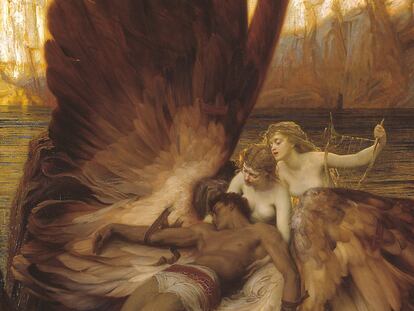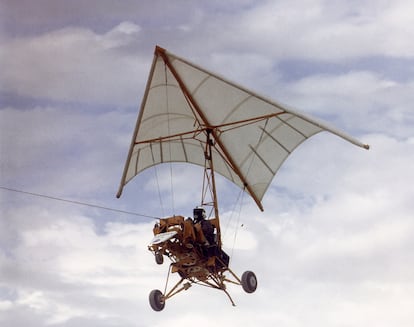We can only take flight if we keep our heads in the clouds
The human desire to fly is as old as time. But trying to imitate storks or bats has led to broken bones, at best

Our unconscious is full of winged beings such as dragons, hippogriffs, harpies and others. Out of all of them, the Phoenix stands out as a bird with bright feathers and a long life that, as we know, rises and is reborn from its own ashes. We also have the legend of Icarus, whose father, Daedalus, built him wings to fly away from Crete. If we continue to list winged creatures, the angels in our mythological tradition also appear with wings on their backs, even in their satanic version.
With such fantasies in mind, in the year 852, the Muslim scholar Abbas Ibn Firnas was given a canvas as a parachute; he decided to emulate the birds and jumped into the void from the minaret of the Mosque of Córdoba in Spain. Not satisfied with the result, he continued experimenting and, twenty years later, he repeated the same feat, this time armed with two wooden wings covered with fabric. The resulting fall broke his legs. Some people’s fantasies know bounds when it comes to flying with the birds.
Continuing in the same vein, in the 11th century, Eilmer of Malmesbury, a Benedictine monk at the English Abbey of Malmesbury, was absorbed by the myth of Icarus — which he believed to be real — and built himself wings by fitting them to his arms with a wooden structure. He then threw himself from the top of one of the abbey’s towers. He flapped his wings and after managing to stay in the air for a few seconds, he finally fell to the ground, breaking his legs.

Around 1250, Roger Bacon conducted the first scientific studies of a flying machine. Toward the end of the 15th century, Leonardo da Vinci was inspired by the wings of bats to design his ornithopter; the machine would soar through the air using pedals. But it was a waste of anticipatory imagination; at the beginning of the 19th century, the Swiss Jakob Degen perfected it and put it into practice with a hydrogen balloon to help in the elevation process.
However, it was not until the end of the 19th century that the birdman reached his nearly definitive version. Otto Lilienthal included his studies in his book Birdflight as the Basis of Aviation: A Contribution Towards a System of Aviation, a work that collects the observations Otto and his brother Gustav made based on the flight of storks; the stork seemed to have been tailor-made to serve as a model for humans to achieve their dream of flying, as Antonio Martínez Ron writes in his book Algo nuevo en los cielos [Something New in the Skies].
Determined to put his theories into practice, Otto made a series of models that he used to imitate storks in flight. Otto Lilienthal became famous for flying downwind on fabric wings. On one of those flights, the wind changed direction and Otto plummeted to his death.
During these summer days with clear skies, when the most daring people try air sports, we must remember that the invention of the engineless aerodyne is the result of a lot of daring and many broken bones that began one fine day when a Muslim scholar residing in Córdoba, Spain, decided to imitate the flight of birds by jumping from the tower of a mosque.
From that point on, it was centuries before Francis Rogallo, a NASA engineer, developed the flexible wing, which John Dickenson adapted in 1963 to become what we know today as a hang glider.
Sign up for our weekly newsletter to get more English-language news coverage from EL PAÍS USA Edition
Tu suscripción se está usando en otro dispositivo
¿Quieres añadir otro usuario a tu suscripción?
Si continúas leyendo en este dispositivo, no se podrá leer en el otro.
FlechaTu suscripción se está usando en otro dispositivo y solo puedes acceder a EL PAÍS desde un dispositivo a la vez.
Si quieres compartir tu cuenta, cambia tu suscripción a la modalidad Premium, así podrás añadir otro usuario. Cada uno accederá con su propia cuenta de email, lo que os permitirá personalizar vuestra experiencia en EL PAÍS.
¿Tienes una suscripción de empresa? Accede aquí para contratar más cuentas.
En el caso de no saber quién está usando tu cuenta, te recomendamos cambiar tu contraseña aquí.
Si decides continuar compartiendo tu cuenta, este mensaje se mostrará en tu dispositivo y en el de la otra persona que está usando tu cuenta de forma indefinida, afectando a tu experiencia de lectura. Puedes consultar aquí los términos y condiciones de la suscripción digital.











































